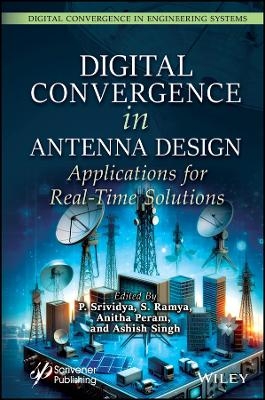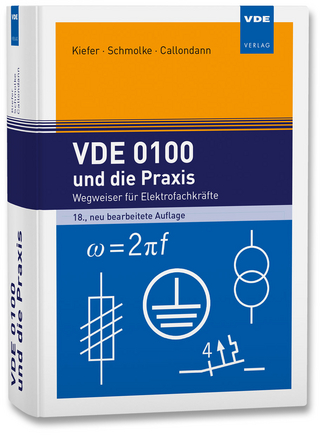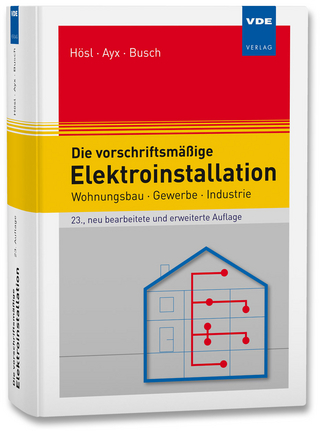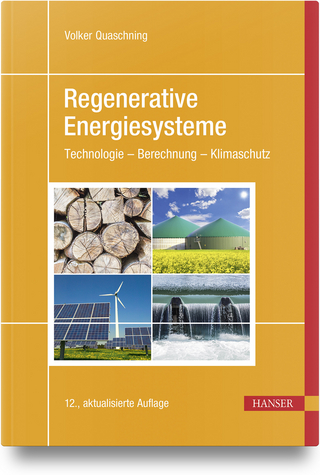
Digital Convergence in Antenna Design
Wiley-Scrivener (Verlag)
978-1-119-87970-1 (ISBN)
This book is intended to disseminate recent trends in antenna designs for real-time applications that leverage digital convergence. The book intends to report the latest research findings, as well as the state-of-the-art RF techniques related to antennas, RFID, filters, etc., with special emphasis on real-time applications like e-health, RADAR, and mobile and satellite communications.
The book can be used as a reference for researchers who want to explore the convergence of AI/ML/DL, big data, and IoT in the areas of antenna and advanced communication technologies for real-time applications. These real-time applications can include e-healthcare, intelligent transportation, aerospace, retail, manufacturing, industrial plants, and defense products where communications play a major role.
P. Srividya, PhD, is an associate professor in the Department of Electronics and Communication Engineering at the RV College of Engineering, Bengaluru, India. She has over 14 years of experience in teaching and has published a number of works in international journals and conferences, as well as six book chapters. S. Ramya, PhD, is an assistant professor in the Department of Electronics and Communication Engineering at the RV College of Engineering, Bengaluru, India. She has over 18 years of teaching experience, as well as more than 15 publications in reputed international journals and conferences. Anitha Peram, PhD, is an associate professor at Sri Jagadguru Balagangadhara Natha Maha Swamiji Institute of Technology, Bangalore, India. She has over 14 years of teaching experience and 14 publications in international journals. She has also been a part of developing a number of faculty development programs in the area of antennas. Ashish Singh, PhD, is an Associate professor in the Department of Computer and Communication Engineering at the NMAM Institute of Technology, Karnataka, India. He has over 14 years of teaching experience and five years of research experience. He also has over 55 publications in reputed national and international journals and conferences. His areas of interest are Nano Antenna, Patch Antenna, and Optical Devices.
List of Figures xi
List of Tables xvii
Preface xix
Section 1: 5G and its Applications 1
1 5G and Cognitive Radio 3
Dr. Nagamani K. and Dr. Bhagya R.
1.1 Introduction 4
1.2 5G System Architecture 5
1.3 An Overview of Network Elements 6
1.4 Design Problems 8
1.5 5G Infrastructure Needs 9
1.6 Features 10
1.7 5G Network Slicing 11
1.8 Pros of 5G 12
1.9 Cons of 5G 13
1.10 5G Applications 14
1.11 Cognitive Radio 15
1.12 Cognitive Radio Network 16
1.13 Spectrum Sensing in CRNs 17
1.14 Classification of CR Spectrum Sensing 17
1.15 Methods of Spectrum Sensing 18
1.16 Routing in Cognitive Radio Network 19
1.17 Terminal Capability of CRN 19
1.18 Reconfigurable Capability 20
1.19 Architecture of CRN 22
1.20 Primary System and CR System 23
1.21 Routing Challenges in CRNs 24
1.22 SDR Architecture 25
1.23 Physical Architecture of CR 28
1.24 Operation of CR 29
1.25 Benefits of CR 30
1.26 Challenges Faced by CR 30
1.27 Techniques of Spectrum Sensing 30
1.28 Cooperative SS Techniques 33
2 A Single-Ring SRR Loaded Slot Engraved Rectangular Monopole Antenna for ISM, WLAN, WiMAX, and 5G Application 39
Prasad Jones Christydass, Asha, Chandra Kumar Dixit, Dhanagopal and Praveen Kitti
2.1 Introduction 40
2.2 Design of SRR Loaded Slot Engraved Rectangular Monopole 41
2.3 Parametric Analysis 46
2.4 Results and Discussion 50
2.5 Conclusion 53
3 Compact Wideband 6-GHz Different Radiating Elements MIMO Antenna with Dual-Band for the 5G/WLAN/C-Band Application 57
Shrenik Suresh Sarade and Dr. S. D. Ruikar
3.1 Introduction 58
3.2 Designing of Two-Element and Four-Element MIMO Antenna 62
3.2.1 Two-Element MIMO Antenna with Defected Ground Structure (DGS) 62
3.2.1.1 Optimization of Defected Ground Structure (DGS) in the Ground Plane and Cut Slot in the Radiating Patch 67
3.2.1.2 Result Analysis of Two-Element MIMO Antenna 69
3.2.2 Four-Element MIMO Antenna 74
3.2.2.1 Result Analysis of Four-Element MIMO Antenna 77
3.3 Comparison 81
3.4 Conclusions 82
Section 2: Wireless Communication Applications 87
4 Compact Fractal Wearable Antenna with and without Defected Ground Structure for Wireless Body Area Communications 89
S. Ramesh and S. Chitra
Introduction 90
Design and Methodology of Proposed Antenna 92
Design Process 92
Analysis of Triangular Patch Antenna 93
Defected Ground Structure 94
Proposed Antenna Configuration 94
Results and Discussion 96
S-Parameter 97
Radiation Pattern 97
Specific Absorption Rate (SAR) 98
Prototype Antenna 102
Measured Results 103
Measurement of S11 103
Comparison of Simulated and Measured Results 104
Return Loss 104
Radiation Pattern 104
Conclusion 104
Acknowledgement 110
References 110
5 A Novel Defected Ground Structure Based Analysis of Micro Strip Patch Antenna for Modern Radar Application 113
Amrees Pandey, J. A. Ansari and Iqra Masroor
5.1 Introduction 114
5.1.1 Antenna Design and Evolution of the Proposed Design Model 116
5.1.2 Results and Discussion 118
5.2 Conclusion 128
6 A Reconfigurable Antenna for C Band Applications 133
Banuprakash R., Vishakha Yadav, Dwarakanath G. V. and S. A. Hariprasad
6.1 Introduction 133
6.2 Structure of Antenna 138
6.3 Results and Discussions 139
6.3.1 Intermediate Steps 141
6.3.2 Gain 144
6.3.3 Radiation Pattern 145
6.3.4 Reconfigurable Antenna Prototype 146
6.4 Conclusion 151
7 Split-Ring Resonator--Inspired Polygonal-Shaped Printed Antenna for Wireless Application 153
Prasad Jones Christydass S., Saravanakumar R., Regina S. and Malaisamy K.
7.1 Introduction 154
7.2 Design of SRR-Inspired Polygonal Antenna 156
7.3 Parametric Analysis 160
7.4 Result and Discussion 162
7.5 Conclusion 167
References 168
Section 3: MIMO Techniques 171
8 Dielectric Resonator Antenna for Multiple Input Multiple Output Applications 173
Mehaboob Mujawar and Subuh Pramono
8.1 Dielectric Resonator Antennas (DRA) 174
8.2 Multiple Inputs and Multiple Outputs (MIMO) 175
8.3 Comparative Study of Different DRA Antennas for MIMO Applications 176
8.4 H-Shaped DRA MIMO Antenna 183
8.5 Results 184
8.6 Conclusion 187
9 A Circular Waveguide Polarizer Based on Periodic Metallic Structure Loading 191
Swati Varun Yadav and Ashish Chittora
9.1 Introduction 191
9.2 Design Principle and Structure 195
9.3 Result and Discussion 197
9.4 Conclusions 202
10 A Metamaterial-Inspired Monopole Antenna for Multi-Resonance Applications 207
Chetan S. and Chandrappa D. N.
10.1 Introduction 207
10.2 Reduction of Electrical Size 209
10.3 Reduction of Coupling Effects 209
10.4 Shaping of Aperture Field -- Directivity and Gain Enhancement 210
10.5 Scanning of Main Beam Direction 210
10.6 Design of Rectangular Split-Ring Metamaterial Unit Cell 210
10.7 Design of Metamaterial-Loaded Monopole Antenna 213
10.8 Design of Monopole Antenna with Metamaterial 215
10.9 Conclusion 217
11 Energy-Efficient Technique to Improve the System Using MIMO 223
Manjunath Managuli, Mahantesh K., M. Lakshminarayana and Sangamesh C. Managuli
Introduction 223
Antenna Node Construction 224
System Specifications 227
Practical Requirements 228
Non-Useful Requirements 228
H/S Requirements 228
Software Environment and Instrument 228
Programming Language 228
C++ Language 229
OTCL Script 229
AWK Characters 229
Prefaces to NST 230
User Vision of System 230
Structure Architecture Design 231
Complete Aim 232
Flow Chart 233
Sequence Diagram 233
Implementation 234
System Component 234
Power Component 235
Node Power Estimate 236
Self-Adaptive Sleep/Awake Module 237
Performance Analysis Module 238
Existing System -- Self-Adaptive Sleep/Awake Algorithm Screenshot 238
Proposed System -- Energy Efficient Method to Improve Network Lifetime Using MIMO Screenshots 242
Testing 244
Levels of Testing 244
Initialization Testing 245
Functional Testing 245
Results and Analysis 245
Self-Adaptive Sleep/Awake Algorithm Performance Metrics Screenshots 247
Performance Measures -- Existing System 248
XGraph -- Average Throughput 248
X-Graph -- Average End-to-End Delay 249
X-Graph -- Overhead 250
X-Graph -- Average Energy 251
Conclusions 252
References 253
About the Editors 257
Index 259
| Erscheinungsdatum | 13.03.2024 |
|---|---|
| Reihe/Serie | Digital Convergence in Engineering Systems |
| Sprache | englisch |
| Gewicht | 717 g |
| Themenwelt | Technik ► Elektrotechnik / Energietechnik |
| ISBN-10 | 1-119-87970-1 / 1119879701 |
| ISBN-13 | 978-1-119-87970-1 / 9781119879701 |
| Zustand | Neuware |
| Informationen gemäß Produktsicherheitsverordnung (GPSR) | |
| Haben Sie eine Frage zum Produkt? |
aus dem Bereich


